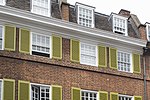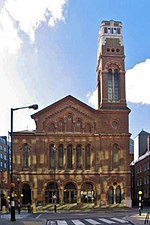Tart Hall
Demolished buildings and structures in LondonFormer houses in the City of WestminsterUse British English from May 2023

Tart Hall or Tart House was a small villa in the City of Westminster, London in the 17th century into the early 18th century. The building stood on the west side of James Street, now Buckingham Gate, immediately to the south of Buckingham House, now Buckingham Palace, at the west end of St James's Park. The origin of its name is not clear. The site was bought by Alethea Howard, Countess of Arundel in 1633, although it is likely it was being leased before then. She had the house built, replacing or enlarging an existing building. The hall was sold in 1742 and demolished.
Excerpt from the Wikipedia article Tart Hall (License: CC BY-SA 3.0, Authors, Images).Tart Hall
Birdcage Walk, London Victoria
Geographical coordinates (GPS) Address Nearby Places Show on map
Geographical coordinates (GPS)
| Latitude | Longitude |
|---|---|
| N 51.5 ° | E -0.14 ° |
Address
Wellington Barracks
Birdcage Walk
SW1E 6AY London, Victoria
England, United Kingdom
Open on Google Maps










